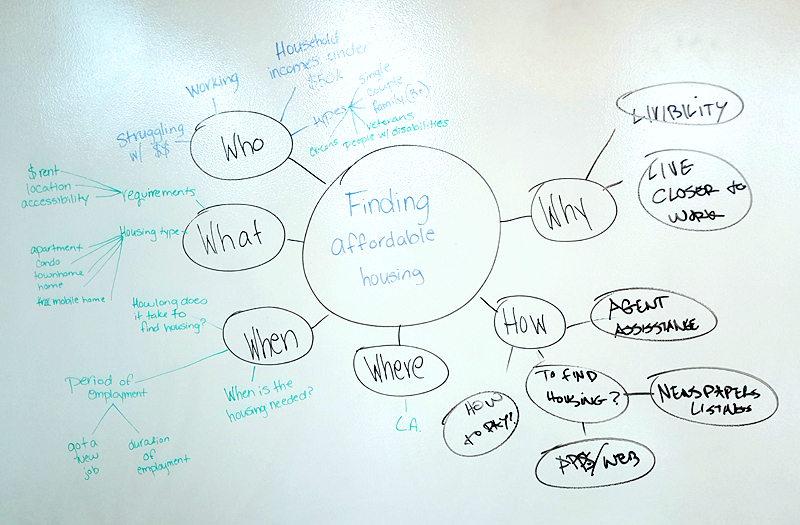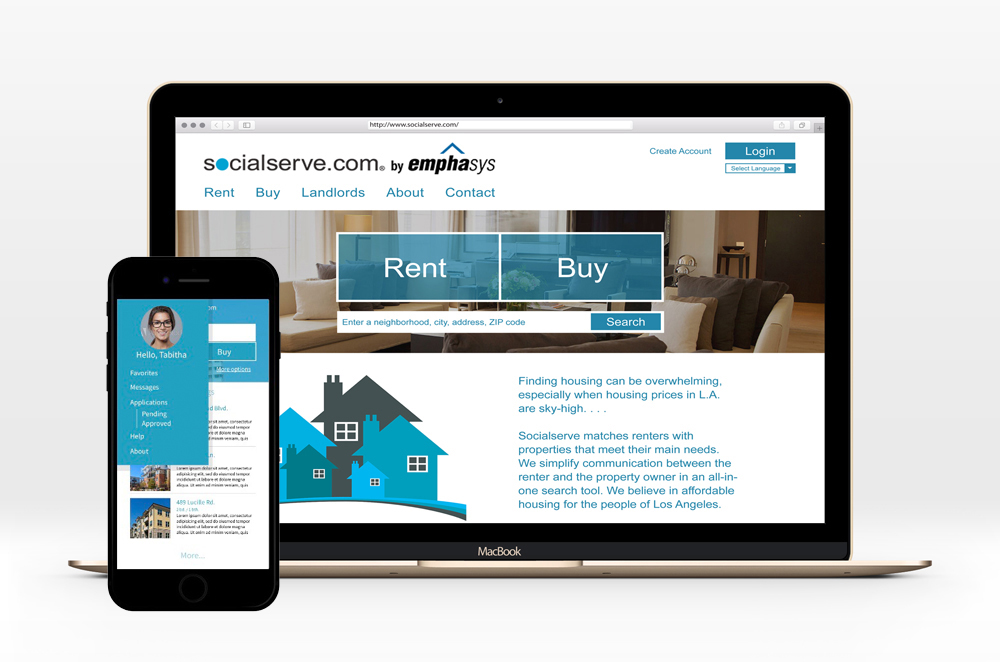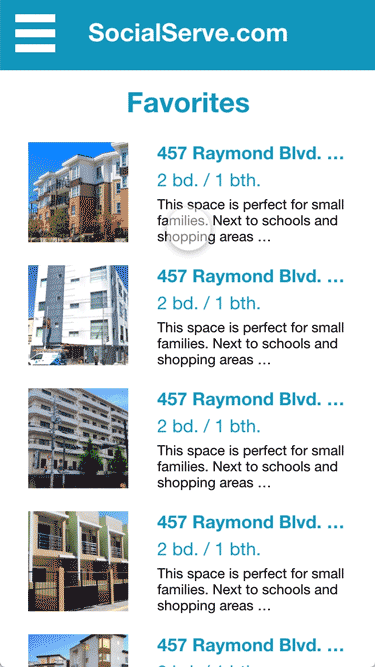Socialserve.com: Usability Study
Role: UX Designer and Research
Platform: Web/Mobile Web
Challenge: The challenge was to create a pleasant experience for people looking for low-income (or close to) housing on socialserve.com by implementing features normally found on other commercial housing sites.
Solution: Bring socialserve.com up to date with useful tools such as user profiles, a map that plots housing locations, a favorites system that allows user to compare their selections for a better shopping experience. As well as giving them information about how they can find government aid and assistance.
Tools: Balsamiq, Sketch, Invision, Adobe InDesign, Google Slides
Timeline: 2 months
Favoriting
One of the biggest problems we noticed from the experience of shopping for a new place on the current site was the difficulty of saving the places you want to revisit. We wanted to implement an easier way of not only saving user searches but give the shopper the ability to compare the properties that they were interested in.
Tailored Experiences
Also, in order to create a more tailored experience, we gave the user account more function by allowing them to generate a more robust user profile. This allowed several possibilities, including auto-filling tedious application forms, giving property managers an opportunity to pre-screen the shopper, and providing the shopper a place to keep track of their searches.
Quicker and Easier
Looking for something specific? We learned that when the shoppers were in their early stages of searching they were still uncertain about exactly how much they could afford. So we made it easier for the shopper to adjust their price range by giving them filters that could further customize their criteria.
Communication
Once the shopper has found a place they’re interested in, they can learn more about the property by checking out its page. Here, the property manager was given the opportunity to provide more information as well as their contact to make the application process more simple.
Read more about our process below…
Inspiration | Ideation | Implementation
Problem
Apartment hunting can be fun, but as a young professional with a small family that depends on an income that falls under what is classified as the city’s poverty level, it can be very difficult to find a location that you can comfortably call home. While the government has various plans to increase affordable housing with plans of building more housing units to accommodate demands, it will be a while before we see these units. So until then, people need a way to browse for homes, especially in the more “affordable” bracket.
There are many options available online to help find a place to stay, but for the most part, apartment shopping and housing has been a privilege for the affluent. For low-income families, housing is scarce and difficult to afford without government aid.
The most accessible option offered by the city of Los Angeles is socialserve.com, which acts as a service that provides affordable housing options. The issues that we have come to recognize through user interviews are as follows:
- Missing the ability to save searches.
- A lack of a filtering system that lets shoppers customize their search results.
- Navigation of the site can be difficult and unintuitive.
The Challenge
The challenge was to create a pleasant experience for people looking for low-income housing on socialserve.com by implementing features normally found on other commercial housing sites.
In it’s current state, socialserve.com’s aesthetics is dated and not adaptive nor responsive to the plethora of screen sizes available on today’s devices.
By default, a user has hesitation trusting the site and does not understand how to search using it’s dated method of drilling through links.

The Socialserve story
Our project started with a problem. Rent is expensive in L.A. and it’s difficult to find good housing. We found the need for a housing search tool specific to low-income renters working in large cities. Competitor research revealed a website which is already trying to solve the low-income housing problem. Socialserve.com is a non-profit online affordable housing locator. The website has great potential, but lacks the intuitive user interface and functionalities necessary for a successful housing search tool.
Instead of trying to create a competing service from scratch, we decided to renovate the existing socialserve.com site.
Goals:
- Improve the Socialserve rental housing search experience
- Make Socialserve a resource for government housing assistance
Hypothesis
By implementing a user profile into socialserve and simplifying communication between renter and property management, we can match the renter with housing that meets their main needs.
We believe that an all-in-one housing search tool, specific to low-income housing, will achieve affordable housing for people living in large cities.
INSPIRATION
User Test Screener
For our research, we had to pool a specific group of people. We asked a few friends that fit the description as well as created a screening post. So we posted a public Facebook post asking for the following:
- People who are looking for housing or who recently moved.
- Making under 40k/yr. Per household
- Working or looking for work in the city
Research Questions
We conducted 9 user interviews consisting of both male and female ranging from the ages of mid 20’s to late 40’s and asked them specific questions about how they typically go about looking for new housing and most importantly how it made them feel.
- How are you finding housing?
- What is proving difficult?
- The best part of your search?
- How far do you live from work?
- Are you happy about your current living situation?

Affinity Map
From the user interviews that we conducted, we began to put together an affinity map to help us better understand the type of people we are trying to serve. The affinity map allowed us to chunk ideas and notice patterns. This helped us with site-mapping and allowed us to later imagine how the user journey would be set.
What we found
We found through qualitative research that…
The top priority of our target market is location. People are willing to pay more for a better location.
- Distance to work
- Distance to public transportation
- Community culture
What we proved
Expensive housing is a problem. All our interviewees were spending more than 30% of their monthly paychecks on rent. Finding affordable housing is difficult in major cities, such as L.A.. Through user testing, we were able to validate the need of a service that helped users not only find affordable housing, but also help them find ways to alleviate their worries of monthly costs of living.
So who Needs socialserve.com?
- Low-income families
- Young professionals starting their careers
- People with disabilities and strict requirements of living
Meet the Simpsons
 Mr. Simpson recently lost his job and Mrs. Simpson works 5 days a week as a travel agent in LA. The Simpsons need to move to a 2-bedroom condo in a safe community. Since they are living on a single-income, they need to quickly find a cheaper place where rent is no more than 30% of monthly income.
Mr. Simpson recently lost his job and Mrs. Simpson works 5 days a week as a travel agent in LA. The Simpsons need to move to a 2-bedroom condo in a safe community. Since they are living on a single-income, they need to quickly find a cheaper place where rent is no more than 30% of monthly income.
- High cost of housing in Los Angeles.
- Finding a new house takes a lot of time.
- Safety & quality of housing and schools in low-income areas.
- Lack of an easy, all-in-one tool to find inexpensive housing.
- Find affordable housing within walking distance of a school.
- Contact property owners and submit rental applications.
- Raise children well and have a happy marriage.
- Be relaxed when searching for new housing.
Meet George
 George is a freelance graphic designer that has a few clients scattered around the LA metro area. Though he is usually busy with his work, he finds it hard to make enough money to live somewhere that doesn’t require him to spend time commuting in and out of the city.
George is a freelance graphic designer that has a few clients scattered around the LA metro area. Though he is usually busy with his work, he finds it hard to make enough money to live somewhere that doesn’t require him to spend time commuting in and out of the city.
Frustrations
- Finding a place that is convenient in price and location to potential employment
- Finding time to shop/compare apartments
- The current solution is uninteresting to use and requires too much time to be comfortable to use
- Finding a user-friendly, easy-to-navigate, service that offers many options of living/employment/entertainment
Goals
- To find full-time employment
- Repair/replace his car
- Meet people and network in his community
Renter Frustrations
- Finding a place that is convenient in price and location to employment
- Finding time to shop/compare.
- Lack of an easy, all-in-one tool to find inexpensive housing.
- Finding a user-friendly, easy-to-navigate, service that offers many options for living, employment, and entertainment
- Safety & quality of housing in low-income areas.
Competitive Analysis
Web services such as Zillow, Apartments.com, Craigslist and Trulia were included in our competitive analysis. These were some of the most familiar services that our users were using to look for housing.
IDEATION
What we discovered
Socialserve lacks important features of a successful housing search tool.
- An intuitive user interface which generates user trust
- Simple search
- A wide variety of listings
- User profiles
- Communication between the renter and the property manager
- Social media sign-in
- A mobile website
To do: Features & Functions to add to Socialserve
- Search by location
- View by gallery or map
- Mark listings as “favorite”
- Compare favorite listings
- Contact property managers through socialserve
- Apply for housing through socialserve
- A mobile website
MVP
A housing search tool with a variety of listings. We want to create an enjoyable shopping experience with socialserve.com while allowing shoppers a way to learn if they qualify for government assistance.
Paper Prototypes
Paper prototypes let us create the general appearances without having to use a computer.
- Quick
- Cheap
- Good way to figure out user flows
Usability Testing Findings
Task: Join Socialserve, then find and apply for housing.
The website needs to adjust for user error. For example, users may try to log-in when they haven’t yet created an account.
Users make predictions about the website based on their use of similar websites. For example, “At this point a confirmation message should display.”
User Flowchart
 With more functions being implemented, the user flowchart became more complex, a user would need to know how to navigate the new features.
With more functions being implemented, the user flowchart became more complex, a user would need to know how to navigate the new features.
Low-fi Prototype (Balsamiq)
Using balsamiq, we were able to build a low fidelity prototype for testing.
- Quick
- Simple
- Interactive
- Collaborative
Here is a user test conducted by my partner, Chelsey. We wrote down a few prompts for the tester to follow and directed them to speak out loud as they went through the prototype.
IMPLEMENTATION
Hi-fi Prototype (Invision)
While taking some branding queues from the original site design, we created a few new elements as well as implemented a pattern library that consisted of pop-up forms. This was decision was made as a solution to the issue of losing your progress when being redirected to another page to fill out an application form. From the user tests, we recieved feedback about the frustration of losing their place in their search process because they would have to load a new page just to fill a form. So instead, we proposed to use a pop-up form with basic information fields that would autofill new applications.
This is the initial hi-fidelity prototype we created. We presented this to a set of new users to get some more feedback and examined their experience with the new redesign compared to the test group of the old website. https://invis.io/ZGCCSEM7D
Conclusion
While we have solved for the usability issues that we have observed in the original website, we have discovered that usability was the least of the concerns as far as trying to make socialserve actually useful for it’s target demographic. We have learned that most people that in need of low-income housing also are in need for assistance in related areas, such as employment and health. So this will be an ongoing project to try to bring more function to the service.
Next Steps
If there were to be more development done to this project, I would look into the process of applying for government housing assistance. From the brief research that I have done, it looks like it can be a very involving process that spans across several different government departments.
I would want to see if I can streamline the process by creating a general application form that can help the applicant get pass the initial qualification screening. And from there I would look into how much time this could save a renter in order to get them into a new home quicker.

























